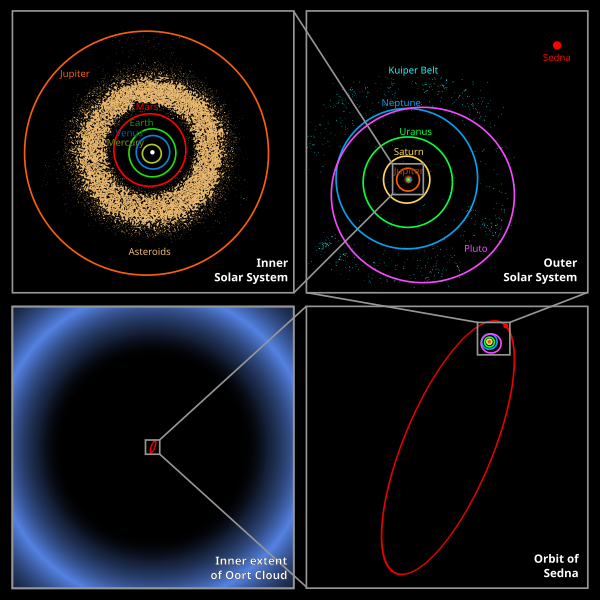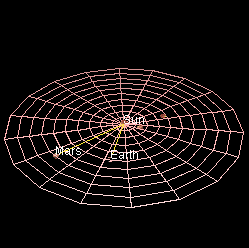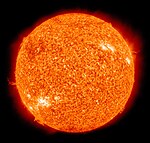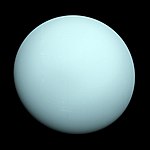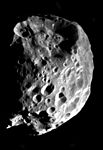The
Solar System[a] comprises the
Sun and the objects that
orbit it, whether they orbit it directly or by orbiting other objects that orbit it directly.
[b] Of those objects that orbit the Sun directly, the largest eight are the planets
[c] that form the
planetary system around it, while the remainder are significantly smaller objects, such as
dwarf planets and
small Solar System bodies (SSSBs) such as
comets and
asteroids.
The Solar System
formed 4.6 billion years ago from the gravitational collapse of a giant
molecular cloud. The vast majority of the system's
mass is in the Sun, with most of the remaining mass contained in
Jupiter. The four smaller inner planets,
Mercury,
Venus,
Earth and
Mars, also called the
terrestrial planets, are primarily composed of rock and metal. The four outer planets, called the
gas giants, are substantially more massive than the terrestrials. The two largest,
Jupiter and
Saturn, are composed mainly of hydrogen and helium; the two outermost planets,
Uranus and
Neptune, are composed largely of substances with relatively high melting points (compared with hydrogen and helium), called
ices, such as water, ammonia and
methane, and are often referred to separately as "ice giants". All planets have almost circular orbits that lie within a nearly flat disc called the
ecliptic plane.
The Solar System also contains regions populated by
smaller objects. The
asteroid belt, which lies between Mars and Jupiter, mostly contains objects composed, like the terrestrial planets, of rock and metal. Beyond Neptune's orbit lie the
Kuiper belt and
scattered disc, linked populations of
trans-Neptunian objects composed mostly of ices. Within these populations are several dozen to more than ten thousand objects that may be large enough to have been rounded by their own gravity.
[10] Such objects are referred to as
dwarf planets. Identified dwarf planets include the asteroid
Ceres and the trans-Neptunian objects
Pluto and
Eris. In addition to these two regions, various other small-body populations, including
comets,
centaurs and
interplanetary dust, freely travel between regions. Six of the planets, at least three of the dwarf planets, and many of the smaller bodies are orbited by
natural satellites,
[e] usually termed "moons" after Earth's
Moon. Each of the outer planets is encircled by
planetary rings of dust and other small objects.
The
solar wind, a flow of
plasma from the Sun, creates a
bubble in the
interstellar medium known as the
heliosphere, which extends out to the edge of the
scattered disc. The
Oort cloud, which is believed to be the source for
long-period comets, may also exist at a distance roughly a thousand times further than the heliosphere. The
heliopause is the point at which pressure from the solar wind is equal to the opposing pressure of
interstellar wind. The Solar System is located in the
Orion Arm, 26,000 light years from the center of the
Milky Way.
Discovery and exploration

Andreas Cellarius's illustration of the Copernican system, from the Harmonia Macrocosmica (1660)
For many thousands of years, humanity, with a few notable exceptions, did not recognize the existence of the Solar System. People believed Earth to be stationary at the centre of the
universe and categorically different from the divine or ethereal objects that moved through the sky. Although the
Greek philosopher
Aristarchus of Samos had speculated on a heliocentric reordering of the cosmos,
[11] Nicolaus Copernicus was the first to develop a mathematically predictive
heliocentric system.
[12] His 17th-century successors,
Galileo Galilei,
Johannes Kepler and
Isaac Newton, developed an understanding of
physics that led to the gradual acceptance of the idea that Earth moves around the Sun and that the planets are governed by the same physical laws that governed Earth. Additionally, the invention of the telescope led to the discovery of further planets and moons. In more recent times, improvements in the telescope and the use of
unmanned spacecraft have enabled the investigation of geological phenomena, such as
mountains and
craters, and seasonal meteorological phenomena, such as
clouds,
dust storms, and
ice caps on the other planets.
Structure and composition

The
orbits of the bodies in the Solar System to scale (clockwise from top left)
The principal component of the Solar System is the Sun, a
G2 main-sequence star that contains 99.86% of the system's known mass and dominates it gravitationally.
[13] The Sun's four largest orbiting bodies, the
gas giants, account for 99% of the remaining mass, with Jupiter and Saturn together comprising more than 90%.
Most large objects in orbit around the Sun lie near the plane of Earth's orbit, known as the
ecliptic. The planets are very close to the ecliptic, whereas comets and
Kuiper belt objects are frequently at significantly greater angles to it.
[17][18] All the planets and most other objects orbit the Sun in the same direction that the Sun is rotating (counter-clockwise, as viewed from a long way above Earth's north pole).
[19] There are
exceptions, such as
Halley's Comet.
The overall structure of the charted regions of the Solar System consists of the Sun, four relatively small inner planets surrounded by a belt of rocky asteroids, and four gas giants surrounded by the Kuiper belt of icy objects. Astronomers sometimes informally divide this structure into separate regions. The inner Solar System includes the four terrestrial planets and the asteroid belt. The outer Solar System is beyond the asteroids, including the four gas giants.
[20] Since the discovery of the Kuiper belt, the outermost parts of the Solar System are considered a distinct region consisting of the objects beyond Neptune.
[21]
Most of the planets in the Solar System possess secondary systems of their own, being orbited by planetary objects called
natural satellites, or moons (two of which are larger than the planet
Mercury), and, in the case of the four
gas giants, by
planetary rings, thin bands of tiny particles that orbit them in unison. Most of the largest natural satellites are in
synchronous rotation, with one face permanently turned toward their parent.
Kepler's laws of planetary motion describe the orbits of objects about the Sun. Following Kepler's laws, each object travels along an
ellipse with the Sun at one
focus. Objects closer to the Sun (with smaller
semi-major axes) travel more quickly because they are more affected by the Sun's gravity. On an elliptical orbit, a body's distance from the Sun varies over the course of its year. A body's closest approach to the Sun is called its
perihelion, whereas its most distant point from the Sun is called its
aphelion. The orbits of the planets are nearly circular, but many comets, asteroids, and Kuiper belt objects follow highly elliptical orbits. The positions of the bodies in the Solar System can be predicted using
numerical models.
Solar System showing the plane of Earth's orbit around the Sun in 3D. Mercury, Venus, Earth, and Mars are shown in both panels; the right panel also shows Jupiter making one full revolution with Saturn and Uranus making less than one full revolution.
Although the Sun dominates the system by mass, it accounts for only about 2% of the
angular momentum[22] due to the differential rotation within the gaseous Sun.
[23] The planets, dominated by Jupiter, account for most of the rest of the angular momentum due to the combination of their mass, orbit, and distance from the Sun, with a possibly significant contribution from comets.
[22]
The Sun, which comprises nearly all the matter in the Solar System, is composed of roughly 98% hydrogen and helium.
[24] Jupiter and
Saturn, which comprise nearly all the remaining matter, possess atmospheres composed of roughly 99% of these elements.
[25][26] A composition gradient exists in the Solar System, created by heat and
light pressure from the Sun; those objects closer to the Sun, which are more affected by heat and light pressure, are composed of elements with high melting points.
Objects farther from the Sun are composed largely of materials with lower melting points.
[27] The boundary in the Solar System beyond which those volatile substances could condense is known as the
frost line, and it lies at roughly 5 AU from the Sun.
[5]
The objects of the inner Solar System are composed mostly of rock,
[28] the collective name for compounds with high melting points, such as
silicates, iron or nickel, that remained solid under almost all conditions in the
protoplanetary nebula.
[29] Jupiter and Saturn are composed mainly of gases, the astronomical term for materials with extremely low melting points and high
vapour pressure, such as
molecular hydrogen,
helium, and
neon, which were always in the gaseous phase in the nebula.
[29] Ices, like
water,
methane,
ammonia,
hydrogen sulfide and
carbon dioxide,
[28] have melting points up to a few hundred kelvins.
[29] They can be found as ices, liquids, or gases in various places in the Solar System, whereas in the nebula they were either in the solid or gaseous phase.
[29]
Icy substances comprise the majority of the satellites of the giant planets, as well as most of Uranus and Neptune (the so-called "
ice giants") and the numerous small objects that lie beyond Neptune's orbit.
[28][30] Together, gases and ices are referred to as
volatiles.
[31]
Distances and scales

Planets of the Solar System to scale. Jupiter and Saturn (top row), Uranus and Neptune (top middle), Earth and Venus (bottom middle), Mars and Mercury.
The distance from Earth to the Sun is 1
astronomical unit (150,000,000
km). For comparison, the radius of the Sun is 0.0047 AU (700,000 km). Thus, the Sun occupies 0.00001% (10
−5 %) of the volume of a sphere with a radius the size of Earth's orbit, whereas Earth's volume is roughly one millionth (10
−6) that of the Sun. Jupiter, the largest planet, is 5.2 astronomical units (780,000,000 km) from the Sun and has a radius of 71,000 km (0.00047 AU), whereas the most distant planet, Neptune, is 30 AU (4.5
×10
9 km) from the Sun.
With a few exceptions, the farther a planet or belt is from the Sun, the larger the distance between its orbit and the orbit of the next nearer object to the Sun. For example, Venus is approximately 0.33 AU farther out from the Sun than Mercury, whereas Saturn is 4.3 AU out from Jupiter, and Neptune lies 10.5 AU out from Uranus. Attempts have been made to determine a relationship between these orbital distances (for example, the
Titius–Bode law),
[32] but no such theory has been accepted. The images at the beginning of this section show the orbits of the various constituents of the Solar System on different scales.
Some
Solar System models attempt to convey the relative scales involved in the Solar System on human terms. Some are small in scale (and may be mechanical—called
orreries)—whereas others extend across cities or regional areas.
[33] The largest such scale model, the
Sweden Solar System, uses the 110-metre (361-ft)
Ericsson Globe in
Stockholm as its substitute Sun, and, following the scale, Jupiter is a 7.5-metre (25-foot) sphere at
Arlanda International Airport, 40 km (25 mi) away, whereas the farthest current object, Sedna, is a 10-cm (4-in) sphere in
Luleå, 912 km (567 mi) away.
[34][35]
If the Sun–Neptune distance is
scaled to 100 metres, then the Sun is about 3 cm in diameter (roughly two-thirds the diameter of a golf ball), the gas giants all smaller than about 3 mm. Earth's diameter along with the other terrestrial planets would be smaller than a flea (0.3 mm) at this scale.
[36]
Distances of selected bodies of the
Solar System from the Sun. The left and right edges of each bar correspond to the
perihelion and
aphelion of the body, respectively. Long bars denote high
orbital eccentricity. The radius of the Sun is 0.7 million km, and the radius of Jupiter (the largest planet) is 0.07 million km, both too small to resolve on this image.
Formation and evolution

Artist's concept of the early Solar System
The Solar System formed 4.568 billion years ago from the gravitational collapse of a region within a large
molecular cloud.
[37] This initial cloud was likely several light-years across and probably birthed several stars.
[38] As is typical of molecular clouds, this one consisted mostly of hydrogen, with some helium, and small amounts of heavier elements fused by previous generations of stars. As the region that would become the Solar System, known as the
pre-solar nebula,
[39] collapsed, conservation of
angular momentum caused it to rotate faster. The centre, where most of the mass collected, became increasingly hotter than the surrounding disc.
[38] As the contracting nebula rotated faster, it began to flatten into a
protoplanetary disc with a diameter of roughly 200
AU[38] and a hot, dense
protostar at the centre.
[40][41] The planets formed by
accretion from this disc,
[42] in which dust and gas gravitationally attracted each other, coalescing to form ever larger bodies. Hundreds of protoplanets may have existed in the early Solar System, but they either merged or were destroyed, leaving the planets, dwarf planets, and leftover
minor bodies.
Due to their higher boiling points, only metals and silicates could exist in solid form in the warm inner Solar System close to the Sun, and these would eventually form the rocky planets of Mercury, Venus, Earth, and Mars. Because metallic elements only comprised a very small fraction of the solar nebula, the terrestrial planets could not grow very large. The giant planets (Jupiter, Saturn, Uranus, and Neptune) formed further out, beyond the frost line, the point between the orbits of Mars and Jupiter where material is cool enough for volatile icy compounds to remain solid. The ices that formed these planets were more plentiful than the metals and silicates that formed the terrestrial inner planets, allowing them to grow massive enough to capture large atmospheres of hydrogen and helium, the lightest and most abundant elements. Leftover debris that never became planets congregated in regions such as the
asteroid belt,
Kuiper belt, and
Oort cloud. The
Nice model is an explanation for the creation of these regions and how the outer planets could have formed in different positions and migrated to their current orbits through various gravitational interactions.
Within 50 million years, the pressure and density of
hydrogen in the centre of the protostar became great enough for it to begin
thermonuclear fusion.
[43] The temperature, reaction rate, pressure, and density increased until
hydrostatic equilibrium was achieved: the thermal pressure equalled the force of gravity. At this point, the Sun became a
main-sequence star.
[44] Solar wind from the Sun created the
heliosphere and swept away the remaining gas and dust from the protoplanetary disc into interstellar space, ending the planetary formation process.
The Solar System will remain roughly as we know it today until the hydrogen in the core of the Sun has been entirely converted to helium, which will occur roughly 5.4 billion years from now. This will mark the end of the Sun's main-sequence life. At this time, the core of the Sun will collapse, and the energy output will be much greater than at present. The outer layers of the Sun will expand to roughly 260 times its current diameter, and the Sun will become a
red giant. Because of its vastly increased surface area, the surface of the Sun will be considerably cooler (2,600 K at its coolest) than it is on the main sequence.
[45] The expanding Sun is expected to vaporize Mercury and Venus and render Earth uninhabitable as the
habitable zone moves out to the orbit of Mars. Eventually, the core will be hot enough for helium fusion; the Sun will burn helium for a fraction of the time it burned hydrogen in the core. The Sun is not massive enough to commence the fusion of heavier elements, and nuclear reactions in the core will dwindle. Its outer layers will move away into space, leaving a
white dwarf, an extraordinarily dense object, half the original mass of the Sun but only the size of Earth.
[46] The ejected outer layers will form what is known as a
planetary nebula, returning some of the material that formed the Sun—but now enriched with
heavier elements like carbon—to the interstellar medium.
Sun

The Sun compared to the planets
The Sun is the Solar System's
star, and by far its chief component. Its large mass (332,900 Earth masses)
[47] produces temperatures and densities in its
core high enough to sustain
nuclear fusion,
[48] which releases enormous amounts of
energy, mostly
radiated into
space as
electromagnetic radiation, peaking in the 400–700 nm band of
visible light.
[49]
The Sun is a type G2
main-sequence star. Compared to the majority of stars in the
Milky Way, the Sun is rather large and bright.
[50] Stars are classified by the
Hertzsprung–Russell diagram, a graph that plots the brightness of stars with their surface
temperatures. Generally, hotter stars are brighter. Stars following this pattern are said to be on the
main sequence, and the Sun lies right in the middle of it. Stars brighter and hotter than the Sun are rare, whereas substantially dimmer and cooler stars, known as
red dwarfs, are common, making up 85% of the stars in the galaxy.
[50][51]
Evidence suggests that the Sun's position on the main sequence puts it in the "prime of life" for a star, not yet having exhausted its store of hydrogen for nuclear fusion. The Sun is growing brighter; early in its history its brightness was 70% that of what it is today.
[52]
The Sun is a
population I star; it was born in the later stages of the
universe's evolution and thus contains more elements heavier than hydrogen and helium ("
metals" in astronomical parlance) than the older population II stars.
[53] Elements heavier than hydrogen and helium were formed in the
cores of ancient and exploding stars, so the first generation of stars had to die before the universe could be enriched with these atoms. The oldest stars contain few metals, whereas stars born later have more. This high metallicity is thought to have been crucial to the Sun's development of a
planetary system because the planets form from the accretion of "metals".
[54]
Interplanetary medium
The vast majority of the Solar System consists of a near-
vacuum known as the
interplanetary medium. Along with
light, the Sun radiates a continuous stream of charged particles (a
plasma) known as the
solar wind. This stream of particles spreads outwards at roughly 1.5 million kilometres (932 thousand miles) per hour,
[55] creating a tenuous atmosphere (the heliosphere) that permeates the interplanetary medium out to at least 100 AU (see
heliopause).
[56] Activity on the Sun's surface, such as
solar flares and
coronal mass ejections, disturb the heliosphere, creating
space weather and causing
geomagnetic storms.
[57] The largest structure within the heliosphere is the
heliospheric current sheet, a spiral form created by the actions of the Sun's rotating magnetic field on the interplanetary medium.
[58][59]
Earth's magnetic field stops
its atmosphere from being stripped away by the solar wind.
[60] Venus and Mars do not have magnetic fields, and as a result the solar wind is causing their atmospheres to gradually bleed away into space.
[61] Coronal mass ejections and similar events blow a magnetic field and huge quantities of material from the surface of the Sun. The interaction of this magnetic field and material with Earth's magnetic field funnels charged particles into Earth's upper atmosphere, where its interactions create
aurorae seen near the
magnetic poles.
The heliosphere and planetary magnetic fields (for those planets that have them) partially shield the Solar System from high-energy interstellar particles called
cosmic rays. The density of cosmic rays in the
interstellar medium and the strength of the Sun's magnetic field change on very long timescales, so the level of cosmic-ray penetration in the Solar System varies, though by how much is unknown.
[62]
The interplanetary medium is home to at least two disc-like regions of
cosmic dust. The first, the
zodiacal dust cloud, lies in the inner Solar System and causes the
zodiacal light. It was likely formed by collisions within the asteroid belt brought on by interactions with the planets.
[63] The second dust cloud extends from about 10 AU to about 40 AU, and was probably created by similar collisions within the
Kuiper belt.
[64][65]
Inner Solar System
The inner Solar System is the traditional name for the region comprising the terrestrial planets and asteroids.
[66] Composed mainly of
silicates and metals, the objects of the inner Solar System are relatively close to the Sun; the radius of this entire region is shorter than the distance between the orbits of Jupiter and Saturn.
Inner planets

The inner planets. From left to right:
Earth,
Mars,
Venus, and
Mercury (sizes to scale, interplanetary distances not)
The four inner or terrestrial planets have dense,
rocky compositions, few or no
moons, and no
ring systems. They are composed largely of
refractory minerals, such as the
silicates, which form their
crusts and
mantles, and metals, such as
iron and
nickel, which form their
cores. Three of the four inner planets (Venus, Earth and Mars) have
atmospheres substantial enough to generate
weather; all have
impact craters and
tectonic surface features, such as
rift valleys and
volcanoes. The term
inner planet should not be confused with
inferior planet, which designates those planets that are closer to the Sun than Earth is (i.e. Mercury and Venus).
Mercury
- Mercury (0.4 AU from the Sun) is the closest planet to the Sun and the smallest planet in the Solar System (0.055 Earth masses). Mercury has no natural satellites; besides impact craters, its only known geological features are lobed ridges or rupes, probably produced by a period of contraction early in its history.[67] Mercury's almost negligible atmosphere consists of atoms blasted off its surface by the solar wind.[68] Its relatively large iron core and thin mantle have not yet been adequately explained. Hypotheses include that its outer layers were stripped off by a giant impact; or, that it was prevented from fully accreting by the young Sun's energy.[69][70]
Venus
- Venus (0.7 AU from the Sun) is close in size to Earth (0.815 Earth masses) and, like Earth, has a thick silicate mantle around an iron core, a substantial atmosphere, and evidence of internal geological activity. It is much drier than Earth, and its atmosphere is ninety times as dense. Venus has no natural satellites. It is the hottest planet, with surface temperatures over 400 °C (752°F), most likely due to the amount of greenhouse gases in the atmosphere.[71] No definitive evidence of current geological activity has been detected on Venus, but it has no magnetic field that would prevent depletion of its substantial atmosphere, which suggests that its atmosphere is frequently replenished by volcanic eruptions.[72]
Earth
- Earth (1 AU from the Sun) is the largest and densest of the inner planets, the only one known to have current geological activity, and the only place where life is known to exist.[73] Its liquid hydrosphere is unique among the terrestrial planets, and it is the only planet where plate tectonics has been observed. Earth's atmosphere is radically different from those of the other planets, having been altered by the presence of life to contain 21% free oxygen.[74] It has one natural satellite, the Moon, the only large satellite of a terrestrial planet in the Solar System.
Mars
- Mars (1.5 AU from the Sun) is smaller than Earth and Venus (0.107 Earth masses). It possesses an atmosphere of mostly carbon dioxide with a surface pressure of 6.1 millibars (roughly 0.6% of that of Earth).[75] Its surface, peppered with vast volcanoes, such as Olympus Mons, and rift valleys, such as Valles Marineris, shows geological activity that may have persisted until as recently as 2 million years ago.[76] Its red colour comes from iron oxide (rust) in its soil.[77] Mars has two tiny natural satellites (Deimos and Phobos) thought to be captured asteroids.[78]
Asteroid belt
Main article:
Asteroid belt are
small Solar System bodies composed mainly of
refractory rocky and metallic
minerals, with some ice.
[79]
The asteroid belt occupies the orbit between Mars and Jupiter, between 2.3 and 3.3 AU from the Sun. It is thought to be remnants from the Solar System's formation that failed to coalesce because of the gravitational interference of Jupiter.
[80]
Asteroids range in size from hundreds of kilometres across to microscopic. All asteroids except the largest, Ceres, are classified as small Solar System bodies.
[81]
The asteroid belt contains tens of thousands, possibly millions, of objects over one kilometre in diameter.
[82] Despite this, the total mass of the asteroid belt is unlikely to be more than a thousandth of that of Earth.
[16] The asteroid belt is very sparsely populated;
spacecraft routinely pass through without incident. Asteroids with diameters between 10 and 10
−4 m are called
meteoroids.
[83]
Ceres
Ceres (2.77 AU) is the largest asteroid, a
protoplanet, and a dwarf planet. It has a diameter of slightly under 1,000 km, and a mass large enough for its own gravity to pull it into a spherical shape. Ceres was considered a planet when it was discovered in 1801, and was reclassified to asteroid in the 1850s as further observations revealed additional asteroids.
[84] It was classified as a dwarf planet in 2006.
Asteroid groups
Asteroids in the asteroid belt are divided into
asteroid groups and
families based on their orbital characteristics.
Asteroid moons are asteroids that orbit larger asteroids. They are not as clearly distinguished as planetary moons, sometimes being almost as large as their partners. The asteroid belt also contains
main-belt comets, which may have been the source of Earth's water.
[85]
Jupiter trojans are located in either of Jupiter's
L4 or L5 points (gravitationally stable regions leading and trailing a planet in its orbit); the term "trojan" is also used for small bodies in any other planetary or satellite Lagrange point.
Hilda asteroids are in a 2:3
resonance with Jupiter; that is, they go around the Sun three times for every two Jupiter orbits.
[86]
The inner Solar System is also dusted with
rogue asteroids, many of which cross the orbits of the inner planets.
[87]
Outer Solar System
The outer region of the Solar System is home to the gas giants and their large moons. Many short-period comets, including the
centaurs, also orbit in this region. Due to their greater distance from the Sun, the solid objects in the outer Solar System contain a higher proportion of volatiles, such as water, ammonia and methane, than the rocky denizens of the inner Solar System because the colder temperatures allow these compounds to remain solid.
Outer planets
The four outer planets, or gas giants (sometimes called Jovian planets), collectively make up 99% of the mass known to orbit the Sun. Jupiter and Saturn are each many tens of times the mass of Earth and consist overwhelmingly of hydrogen and helium; Uranus and Neptune are far less massive (<20 and="" astronomers="" belong="" category="" class="reference" earth="" for="" giants="" ice="" ices="" id="cite_ref-94" in="" makeup.="" masses="" more="" own="" possess="" reasons="" some="" suggest="" sup="" their="" these="" they="">
[88]









